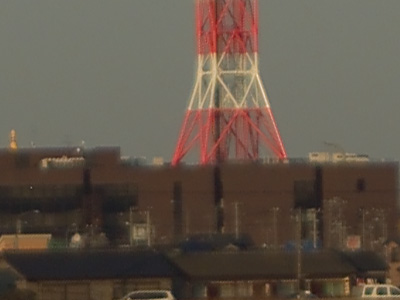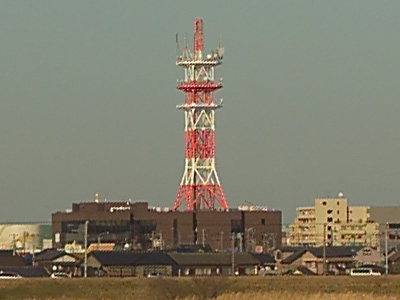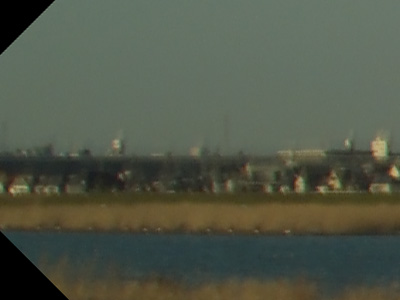
|

All images were shot with the camera set to Aperture Priority mode. The DCR (raw) files were converted to 8-bit TIFF files, then cropped in Photoshop before being saved as JPEGs for web viewing. Except for re-sizing the color balance examples, absolutely no sharpening, color, or levels adjustments were performed. See notes on the limitations of this test at the bottom of this page.
1) Point of focus. The point of focus was the radio tower in the center of the frame, which was as good a focusing target as I could find, but the exact point of focus may vary slightly between lenses. 2) Representative sample. I am using my own lenses for these tests, the two 30mm fisheye lenses and the 55mm shift lens were purchased new, but all other pieces were purchased used. I do not know the history of the used lenses, and so some of them may have been disassembled or serviced prior to their coming into my possession. At any rate, the lenses tested here are assumed to be a "representative sample" of what is commonly available. Variations in manufacture among other things may skew the results, and so these test images may or may not accurately reflect what you can expect from a different lens specimen. 3) "Non-Digital lenses." There is an ongoing debate about the performance capabilities of older lenses on digital sensors. While none of the lenses tested were developed specifically for digital sensors, the Kodak ProBack 645 mounted on the Contax 645 was developed specifically for medium format digital photography and performs superbly even with existing non-digital-specific lenses. While I cannot answer the above-mentioned question with any authority, these tests were conducted with as even a playing field as is currently possible. Most of the results are outstanding and should reflect what is possible when shooting on film as well. 4) Resolving limits of the digital sensor. The CCD sensor in the Kodak ProBack 645 measures 36.72mm x 36.72mm and delivers a 4072 x 4072 pixel image as a 20MB raw and/or 50MB TIFF file. Each pixel measures just 0.009mm on the CCD. The cropped areas above measure 400 x 300 pixels, meaning that it represents a 3.6mm x 2.7mm area on the sensor. If you view these images on a common .26mm dot pitch monitor, it is the equivalent of examining a 5.3 x 5.3 foot print (1.6 x 1.6 meters) from a 6x6 piece of film up close. This is extreme magnification. To put this into perspective, take a few steps back from your monitor and then look at the images again... this would be a little more appropriate for a print viewing distance. 5) No Bronica SQ lens adapter. I don't think a Bronica SQ to Contax 645 adapter was ever manufactured. But placing the back of the Bronica lenses directly against the front of the Pentacon 6 to Contax 645 adapter happens to give good infinity focus. But since there was no way to secure the lens to the adapter, I had to hand hold the lens in place and as a result: the exact placement of the lens between shots varies slightly, the potential of these lenses as far as color and contrast is probably reduced because stray light was able to enter the small gaps between the lens and the adapter, and their overall sharpness could be lowered because I was hand holding them in place. Please take the Bronica lens results with a big grain of salt and consider their inclusion as being just "for fun". 6) Optical de-centering? 50mm Flektogon #1 and the 65mm Flektogon were both previously sent to Hartblei for multi-coating work. The 50mm lens had damaged coatings due to a fireworks festival incident (being too close to the action) and the 65mm Flektogon's light coatings were somewhat scratched up when I got it. I don't think Hartblei disassembled the lenses any more than removing the entire front lens cell... but there is still the possibility of this work having affected their optical performance when examining images at this scale. Then again, maybe they were this way from day one? There can be no answer to this question now. | ||||||||||||||||||||||||||||||||||||||||||||||||||||||||||||||||||||||||||||||||||||||||||||||||||
|
All text and images Copyright © 2005 - Kevin Ing
|



















































































